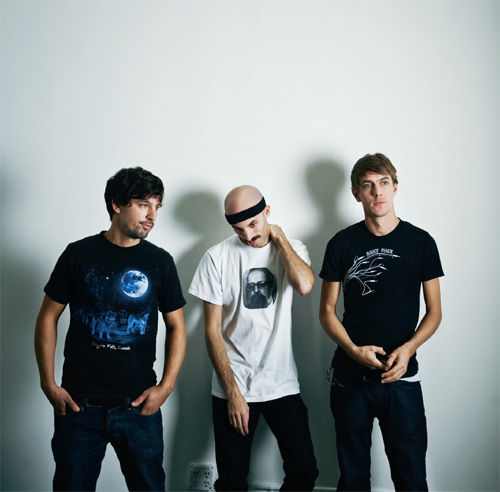
Left to right: DP Holmes, Joe Tomino, and Stu Brooks
Long car rides, too much gas-station coffee, and being surrounded by incompetent drivers on the California interstate have made the members of Dub Trio a little restless this afternoon, but the good-natured band from Brooklyn is taking it in stride.
Crooner Jeffery Osbourne’s 1982 R&B hit “On the Wings of Love” plays over satellite radio, a device, the band agrees, that has infinitely improved road trips. “Oh my god, yeah—it’s a beautiful thing!” guitarist DP Holmes exclaims.
The band is at the tail end of its West Coast tour with Helmet. Next week it’s back east to take off again with fellow New Yorkers and friends Gogol Bordello. Relentless touring is the life of an up-and-coming, hard-working band.
Dub Trio may be in supporting slots now, but it won’t be for long. With five years and four albums under their belts, Holmes, bassist Stu Brooks, and drummer Joe Tomino have gained a reputation as a group that pushes boundaries.
Drawing from rock, metal, punk, ambient, and of course, dub, the trio challenges the notion of the genre for which it is named. Tomino says, “There are not enough interesting voices in the world today—everyone’s kind of doing the same shit, pulling out the same trick.”
In January, Dub Trio released its third full-length studio record, its first for Ipecac Recordings. Produced by long-time studio collaborator Joel Hamilton, Another Sound is Dying is its heaviest, most far-reaching album to date.
Hard-hitting, dynamic, and expansive, the instrumental soundscapes contained on the record are immediately engaging and become more intoxicating upon repeated listens. Using its exceptional musical skills to blend styles and rhythms, Dub Trio openly defies conventions of popular music. It’s enough to make you momentarily question the validity of the rest of your record collection.
“When we’re working with other people, we are restricted and we cater to their musical needs. But when we’re doing Dub Trio, we have absolutely no restrictions musically. We’re able to do whatever we want. That was the attraction.”
Toronto natives Stu Brooks and DP Holmes first met in Boston before moving to New York to pursue their musical careers. When their then-current band found itself without a drummer, a mutual friend introduced them to Joe Tomino, a former Cleveland resident who made the move to New York a couple of years before.
That band soon folded, but the three remained great friends and continued to play music together, often hiring themselves out as a rhythm section for session work and live shows. Their collective studio resume includes names like Macy Grey, Common, The Fugees, and 50 Cent. Although they enjoy working with other artists, playing their own music allows freedom for exploration and expression that by nature, working on someone else’s music does not often permit.
Brooks says, “When we’re working with other people, we are restricted and we cater to their musical needs. But when we’re doing Dub Trio, we have absolutely no restrictions musically. We’re able to do whatever we want. That was the attraction.”
The members of Dub Trio are committed to writing music that they like, even if it is not commercially viable by traditional means.
“We’re not writing songs to be on [NYC radio station] K-Rock,” deadpans Tomino. “We could do that, and we probably in some level production-wise have, but we don’t. We’re Dub Trio. We do what we do, and the rest takes care of itself.”
This attitude is not a new phenomenon. Experimental artists such as Frank Zappa and Tom Waits have questioned whether to use their talents to make music with mass appeal or to play what is in their hearts, and thankfully, their hearts won the debate. What good is art if it hasn’t broken any rules?
In a modern age where middle-school students are learning how to write their own press releases at rock ’n’ roll summer camp, and where winning American Idol symbolizes the epitome of success to many Americans, this truly stands out. Punk and indie rock may still in be in vogue, but what it means to be independent has changed dramatically, now that you can buy the look at the mall and match your taste in music so that it makes the grade on any number of hipster webzines.
Dub music was born in Jamaica in the 1960s and ’70s. Pioneers such as King Tubby and Lee “Scratch” Perry developed techniques to reshape and configure existing songs into brand new versions, or “dubs” (from the word “double”). A predecessor to modern dance styles, dub often dropped vocals and high-end instruments in and out of songs while emphasizing drum rhythms and giving the bass guitar a huge guttural makeover.
Echoes and reverbs were layered on top, and DJs were able to further shape the sounds in a live environment. Dub started out primarily as B-side versions of more pop-friendly songs, but it soon became a popular style in its own right. Dub has left a monumental, yet often unrecognized, impact on the world of modern music.
Tomino speaks about dub the way some people speak about a profound religious experience. “These cats were working with the most minimal, cheap amount of gear they had at their disposal,” he says. “They were in Jamaica in the ‘60s and ‘70s and had no money. Everything was hand made, really budget, saying, ‘I’m going to put drums on track one, guitar on track two, bass on track three, and vocals on track four,’ and just totally coming up with this brand new style. Essentially, this was the birth of the remix. Taking this basic material and coming up with all these ways to reinterpret the music is just amazing.”
